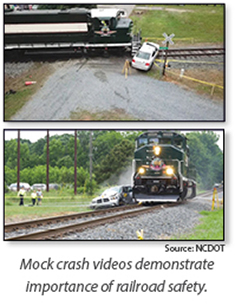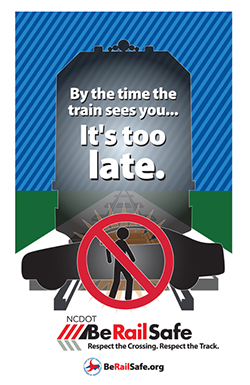Describe the state of roadway safety before the practice was implemented. What was the safety issue, problem, or gap?
Incorrect driver behavior is the number one reason for railway crossing collisions. According to the Federal Railroad Administration (FRA), an annual average of 1,790 collisions and 222 fatalities occurred at public railway-highway crossings from 2009-2018.


Describe the noteworthy practice.
Education is an effective way to help reduce these numbers and ensure drivers, pedestrians, and emergency responders are aware of the dangers of being on and around railroad tracks. Many States and organizations are producing engaging and effective outreach strategies, emphasizing that it is not only what you say—it is how you say it and who you say it to.
What technical and/or institutional changes resulted from the practice?
Operation Lifesaver, Inc. (OLI) is a nonprofit organization providing public education programs in States to prevent collisions, injuries, and fatalities on and around railroad tracks. The State OLI program of North Carolina partnered with North Carolina Department of Transportation (NCDOT) to perform and record a staged crash between a vehicle and a train. The train was traveling at 25 miles per hour, well below typical speeds for freight and passenger trains. The mock crash demonstrated the damage caused when a train collides with a motor vehicle, and the potential for fatal or serious injuries to the driver and passengers, even at this lower speed. The dramatic live demonstration and resulting videos were an innovative way for OLI and NCDOT to educate about the danger near railroads.
NCDOT created a railroad safety campaign, branded BeRailSafe, and a dedicated web page to provide free first-responder training and targeted outreach materials, safety tips, public outreach campaign information, and tools for communicating the risks associated with railways. BeRailSafe resources are grouped by target audience, including children, adults, and first responders, making it easy to find the right piece of outreach material for the right audience.
The FRA found that 59 percent of grade crossing crashes involve drivers between the ages of 20 and 49. To target such an important demographic, the State OLI program of Wyoming placed advertisements in event programs for Professional Bull Riders Association competitions, which typically attract this high-risk group in Wyoming. Teens spend numerous hours a day watching videos on mobile phones, making video campaigns an effective way to reach teen drivers. Noteworthy video projects include:
- OLI created a video series, called Ryan’s Brain, to educate new drivers about safe ways to interact with railways.
- Iowa Department of Transportation (Iowa DOT) created an infographic-style video to demonstrate the value of freight trains to the public and remind drivers that while they have the ability to detour, train conductors do not.
- Connecticut Department of Transportation (CTDOT) Operation Lifesaver Program partners with schools to do safety presentations for school bus drivers, teens, and children. A variety of videos, ranging from cartoons to deadly crashes, are used to help convey the safety message. CTDOT also partners with the Department of Motor Vehicles to display OLI rail safety education videos.
- The National Safety Council created a provocative video showing past crashes to encourage drivers to respect the speed of a trains.

